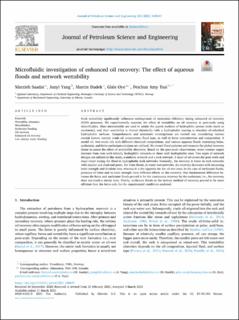| dc.description.abstract | Rock wettability significantly influences underground oil extraction efficiency during enhanced oil recovery (EOR) processes. We experimentally examine the effect of wettability on oil recovery at pore-scale using microfluidics. Glass micromodels are used to mimic the quartz surfaces of hydrophilic porous rocks (such as sandstone), and their wettability is altered chemically with a hydrophobic coating to simulate oil-adsorbed hydrophobic surfaces. Comprehensive and systematic investigations are carried out, considering various crucial factors, namely crude oil components, flood type, as well as brine concentration and composition. A model oil, two crude oils with different chemical compositions, and various aqueous floods containing brine, surfactant, and brine-surfactant solutions are utilized. We record flood patterns and measure the global recovery factor to assess the effect of wettability alteration. Based on the pore-scale observations, water contact angles increase from tests with initially hydrophilic networks to those with hydrophobic ones. Two types of network designs are utilized in this study, a uniform network and a rock network. A layer of oil covers the pore walls and stays intact during the flood in hydrophobic rock networks. Generally, the recovery is lower in rock networks with smaller and dead-end pores. For brine floods, in water-wet networks, the recovery decreases with increasing ionic strength and divalent ions, whereas it is the opposite for the oil-wet ones. In the case of surfactant floods, presence of brine and its ionic strength have different effects on the recovery. One fundamental difference between the brine and surfactant floods proved to be the continuous recovery by the surfactant, i.e., the recovery does not reach a steady state. Finally, surfactant floods as the tertiary method of recovery proved to be more efficient than the brine-only for the experimental conditions explored. | en_US |

